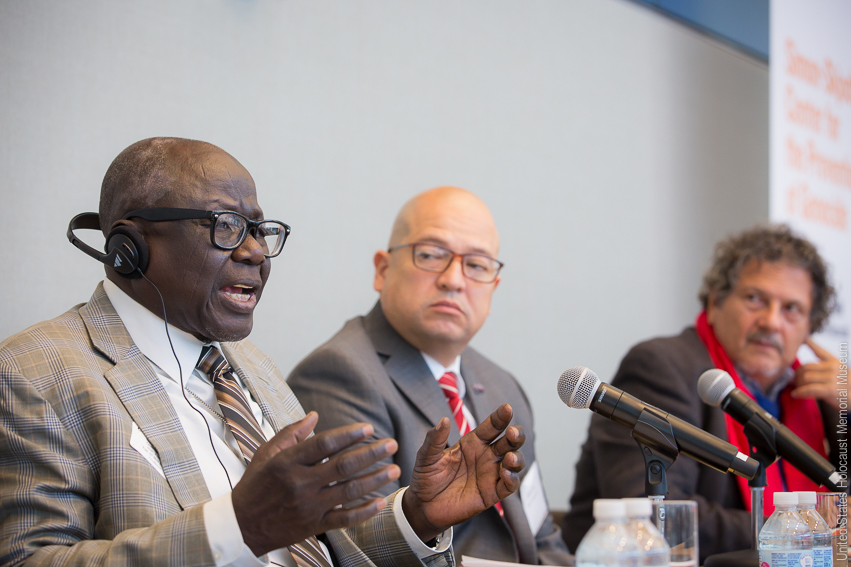April 19, 2021

By Sareta Ashraph, Senior Legal Consultant, US Holocaust Memorial Museum
This contribution by Sareta Ashraph is part of a blog post series to coincide with the launch of our Handbook: "Pursuing Justice for Mass Atrocities: A Handbook for Victim Groups."
In April 1977, Argentina’s Madres de la Plaza de Mayo held their first weekly march against the military commanders who had planned the systematic disappearance and murder of thousands. Four decades on, the mothers continued to march, their white headscarves a symbol of the relentless battle for justice for crimes against humanity committed—a battle in which they have been largely successful, with more than 700 perpetrators sentenced.
Victims of mass atrocity crimes, and the communities from which they come, are at the forefront of efforts to achieve justice for the violence and violations they have suffered. Having lived through the crimes, they are likely to have a deep understanding of the harm and to hold the trust of their community. Consequently, they often serve as points of information and advice to their community, informing other victims about their rights to justice, and the pros and cons of the various legal pathways which may be available. In so doing, they are invaluable in ensuring communities have realistic expectations about the justice process, including the length of time it may take and the fact that a successful outcome cannot, unfortunately, be guaranteed. Some victim groups may decide to be involved in the process of documenting the crimes committed, and may wish to share the information they collect with judicial and accountability mechanisms. And they may choose to become involved in legal proceedings, either by initiating cases or participating in proceedings as victims and witnesses.
Chapter 2 of the Handbook explores the ways in which victim groups can use the law to obtain justice and accountability for mass atrocities. While criminal accountability mechanisms remain the best-known legal pathway towards justice, the chapter also provides an overview of other legal tools, including state responsibility and civil liability mechanisms, as well as tools that address other unlawful acts committed during situations of mass atrocity, such as immigration proceedings and proceedings for transnational crimes and corruption. As most, if not all victim communities know, achieving justice for mass atrocity crimes is rarely a smooth path. The chapter addresses common challenges—lack of jurisdiction, evidential challenges, and the giving of amnesties, among them—and offers strategies for overcoming those challenges. Finally, it discusses what individual victims and victim groups can expect if they decide to bring a case or participate in a case. This includes what to expect if one is a witness in a criminal case or a complainant in civil proceedings. For victim groups intending to file a complaint with a human rights complaint mechanism, the chapter examines the main matters for consideration and provides a short overview of different UN human rights bodies that can adjudicate those complaints.
Victim groups that are considering actively gathering or sharing information with authorities in order to advance justice can turn to Chapter 4 of the Handbook. While victim groups can be invaluable to investigations and other information collection exercises, a survivor-centered, trauma-informed approach requires that those gathering information about specific crimes and perpetrators should have specialized training and oversight. Participating in the gathering of evidence about mass atrocities without that expertise risks putting victims through traumatizing and unnecessary interviews. It can also result in information collected not being able to be used in proceedings, and can increase security risks both to those being interviewed and those conducting the interview. Consequently, this chapter focuses on the collection of information that does not carry with it the risk of causing inadvertent harm and which can be useful to prosecutorial and judicial authorities. This includes collecting information about the background to the conflict, statistical information, such as compiling lists of the missing and killed, and photographs and videos. Gathering, cataloguing, and compiling publicly available information—the chapter notes—may also carry a lower risk of retaliation to victim groups than gathering evidence about specific crimes.
For those victim groups that do decide to engage in documentation, it is essential that steps be taken to protect the information from being lost, leaked, stolen, or destroyed. Even with secure data management, it is important that victim groups assume that mistakes will occur and that communications may be monitored. When it comes to gathering information, victim groups will need to assess their tolerance for risk depending on the context in which they are operating, and consider relying on experts in data protection, storage, and transfer.
Victims and victim groups are an indelible part of achieving justice. In equipping them with information about using the law to advance justice and accountability for mass atrocities, and the roles they can play, the Handbook seeks to deepen their effective involvement in supporting the building of cases, and in so doing, carving a path towards justice.
View All Blog Posts